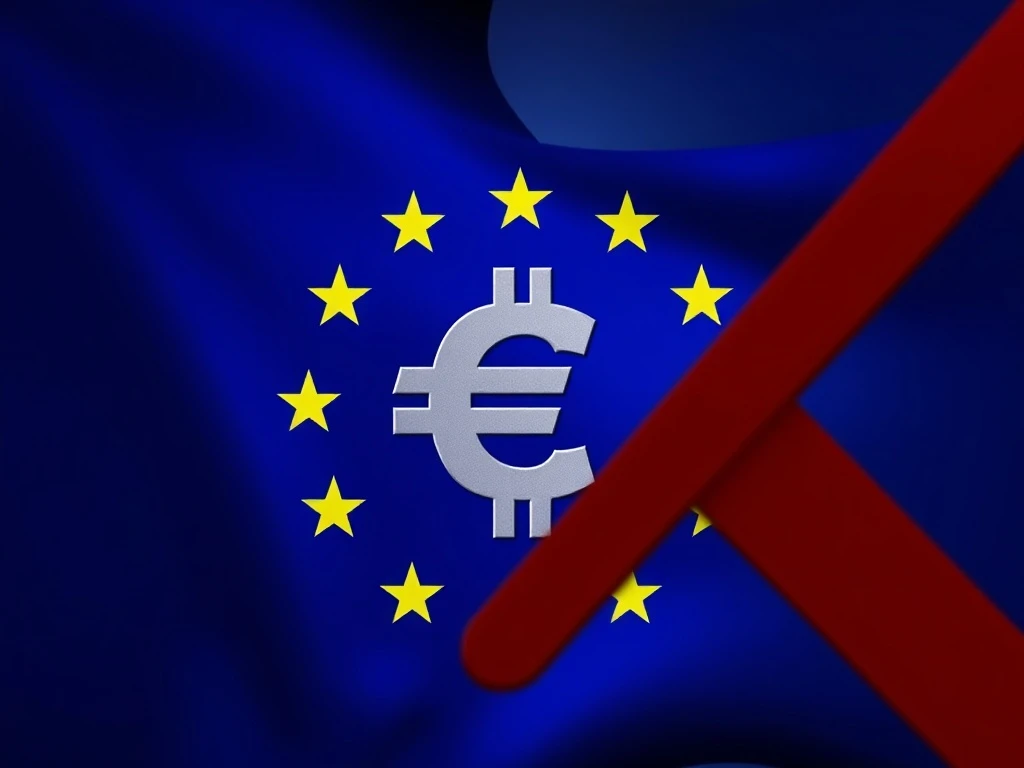EU Stablecoin Ban: Urgent Threat to European Stablecoins Emerges

A significant development is currently shaking the European digital asset landscape. A prominent EU watchdog group has reportedly pushed for an **EU stablecoin ban** on specific types of stablecoins. This move signals a growing apprehension among financial authorities regarding the stability and control of digital currencies. Investors and market participants must pay close attention to these evolving discussions, as they could fundamentally reshape the future of **European stablecoins** and broader **crypto regulation** within the bloc.
Understanding the Proposed EU Stablecoin Ban
Reports indicate that the European Systemic Risk Board (ESRB) recently recommended a ban on multi-issuance stablecoins. This proposal specifically targets tokens issued jointly in the EU and other jurisdictions. The ESRB, a watchdog established to respond to financial crises, passed this recommendation last week. While not legally binding, this policy carries considerable weight. It could significantly pressure national authorities to restrict the operations of major stablecoin issuers. Companies like Circle and Paxos, which currently operate in the region, might face new limitations.
Multi-issuance stablecoins often involve complex structures. They typically rely on multiple entities or jurisdictions for their backing and operation. Regulators view this complexity as a potential vulnerability. It makes oversight challenging and could pose risks to financial stability. The ESRB’s move clearly reflects a cautious approach to novel financial instruments.
The Escalating Stablecoin Regulation Debate
This reported push for an **EU stablecoin ban** does not occur in a vacuum. It follows a series of calls from high-ranking European officials for stricter oversight. European Central Bank (ECB) President Christine Lagarde, just weeks prior, urged policymakers to address crypto regulation gaps. She specifically highlighted concerns about stablecoins issued by non-EU entities. These concerns underscore a broader effort to bring digital assets under a comprehensive regulatory framework.
Moreover, an official from Italy’s central bank echoed these sentiments in September. This official warned that multi-issuance stablecoins presented distinct risks to the EU’s financial stability. Such statements from various influential figures highlight a coordinated regulatory push. They aim to safeguard the financial system from perceived threats posed by unregulated digital assets. The consensus among these bodies suggests that robust **stablecoin regulation** is now a top priority.
Why Regulators Target European Stablecoins
Regulators are primarily concerned about several key areas when it comes to **European stablecoins**. First, they worry about financial stability. Large-scale stablecoin failures could trigger broader market disruptions. Second, monetary policy sovereignty is a major issue. Widespread adoption of private stablecoins, especially those pegged to non-Euro currencies, could undermine the ECB’s control over the money supply. Third, consumer protection remains a critical factor. Users need assurance that their funds are safe and that stablecoin issuers are transparent.
These concerns drive the ongoing discussions around **crypto regulation**. Policymakers want to ensure that any digital currency operating within the EU adheres to stringent standards. They aim to mitigate risks related to:
- **Liquidity management:** Ensuring stablecoins can always meet redemption requests.
- **Reserve asset quality:** Verifying that backing assets are truly safe and liquid.
- **Operational resilience:** Protecting against technical failures or cyberattacks.
- **Anti-Money Laundering (AML) and Counter-Terrorist Financing (CTF):** Preventing illicit use of digital assets.
Therefore, the proposed ban on certain stablecoins is a direct response to these identified vulnerabilities. It represents a proactive step to manage emerging financial risks.
The Digital Euro: Europe’s Alternative Vision
Amidst the debate over an **EU stablecoin ban**, the European Union continues to explore its own central bank digital currency (CBDC). This initiative, known as the **Digital Euro**, began its exploration phase in 2021. Officials view it as a potential alternative to private stablecoins. It aims to provide a safe, reliable, and universally accessible form of central bank money for the digital age. This project reflects Europe’s commitment to innovation while maintaining monetary control.
ECB executive board member Piero Cipollone recently provided an update on the progress. He indicated that EU member states might reach an agreement on the Digital Euro by the end of this year. A possible launch could follow by 2029. Cipollone emphasized its role in preserving Europe’s financial resilience alongside physical cash. The Digital Euro could offer a sovereign, publicly controlled digital payment option. This contrasts sharply with privately issued stablecoins, which face increasing regulatory scrutiny.
Navigating the Future of Crypto Regulation in the EU
The path forward for **crypto regulation** in the EU remains complex. The proposed stablecoin ban, while significant, is not yet legally binding. Its ultimate support among authorities and lawmakers remains uncertain. Some of the largest stablecoins, such as Tether (USDt), are pegged to the US dollar. This adds another layer of complexity to the EU’s regulatory ambitions. The region must consider the global nature of these digital assets.
The EU is actively developing its comprehensive Markets in Crypto-Assets (MiCA) regulation. MiCA aims to provide a harmonized framework for crypto-assets across all member states. This legislation will likely address many of the concerns driving the current stablecoin debate. It will establish clear rules for issuance, operation, and supervision of various crypto-assets, including stablecoins. The ongoing discussions about the **EU stablecoin ban** will undoubtedly influence the final shape of MiCA and future regulatory amendments.
Ultimately, the European Union is striving to strike a balance. It wants to foster innovation in digital finance while protecting consumers and ensuring financial stability. The coming months will be crucial. They will reveal the extent to which these recommendations translate into concrete policies. Market participants should monitor these developments closely. The future landscape for stablecoins and digital assets in Europe hinges on these critical regulatory decisions.









